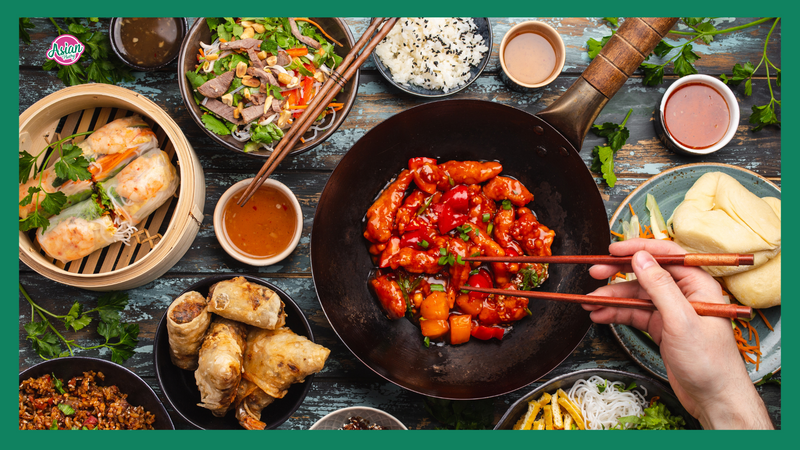Top Asian Cuisine Tips for Authentic Cooking and Enjoying Flavors
Asian cuisine is renowned for its rich flavors, diverse ingredients, and unique cooking techniques. Whether you’re a seasoned chef or a curious beginner, exploring Asian cuisine can be both a rewarding and exciting journey. In this article, we’ll dive deep into tips that will help you master the art of cooking and appreciating the diverse dishes from across the continent.

1. Understanding the Ingredients
Asian cuisine uses a variety of unique ingredients that may not be common in Western kitchens. Learning about these ingredients is essential for cooking authentic dishes.
-
Rice and Noodles: Rice is a staple in many Asian cuisines, from sushi rice in Japan to jasmine rice in Thailand. Noodles, such as soba, pho, and pad Thai, are equally important, and knowing the right kind of noodles for the right dish is essential.
-
Spices and Herbs: Spices like turmeric, cumin, and chili are used to add depth and heat to Asian dishes. Fresh herbs, such as cilantro, mint, and basil, are commonly used for garnish and added flavor.
-
Sauces and Pastes: Familiarize yourself with key condiments like soy sauce, fish sauce, oyster sauce, and hoisin sauce. Each brings its own flavor profile that defines the taste of the dish. For example, soy sauce offers umami, while fish sauce imparts a savory depth to dishes.
Tip: Explore Asian markets to find the freshest and most authentic ingredients.
2. Mastering Basic Cooking Techniques
Asian cuisines rely on specific techniques that bring out the best flavors and textures of the ingredients. Mastering these methods can help elevate your cooking skills.
-
Stir-frying: A quick and high-heat method, stir-frying helps to preserve the texture and color of the vegetables while cooking proteins evenly. It’s a staple in Chinese cooking.
-
Steaming: Steaming is a common technique in Asian kitchens, especially for dumplings and fish, as it preserves the nutrients and delicate flavors of the food.
-
Grilling: Grilling, or barbecuing, is popular in countries like Korea (think of BBQ meats) and Japan (yakitori). This method adds a smoky, charred flavor that enhances the natural taste of meats and vegetables.
“The key to great Asian cooking is balance. Balancing the flavors of sweet, salty, sour, and bitter is essential to achieving a delicious dish.” – Culinary Expert
3. Balancing Flavors in Asian Cuisine
Asian cuisine is all about balance. Understanding how to combine flavors like sweet, salty, sour, and bitter will set your dishes apart from others.
-
Sweetness: Sweetness often comes from sugar, honey, or sweet fruits like pineapple. In dishes like Thai green curry, sweetness is balanced with heat and acidity.
-
Saltiness: Soy sauce and fish sauce are common sources of saltiness. These ingredients add depth and umami to dishes such as miso soup or pho.
-
Sourness: Lime, vinegar, and tamarind are used to introduce a tangy, refreshing element. A dish like Vietnamese pho uses lime to balance the richness of the broth.
-
Bitterness: Bitter elements like bitter melon or certain greens are essential in some dishes. They help cut through the richness of fatty meats or creamy sauces.
Tip: Experiment with different combinations to find what works best for your palate!
4. Regional Variations and Their Unique Qualities
Asian cuisine varies significantly across regions. Each region has its own distinct flavors and dishes, making it an exciting journey to explore.
-
Chinese Cuisine: Known for its bold flavors, Chinese cuisine emphasizes balance with its famous five-spice powder and unique sauces. Popular dishes include Kung Pao chicken, dumplings, and sweet and sour pork.
-
Japanese Cuisine: Japanese dishes focus on fresh, high-quality ingredients with an emphasis on simplicity and seasonality. Sushi, sashimi, and ramen are staples.
-
Indian Cuisine: Indian food is all about spice and aromatics. Dishes like butter chicken, tandoori, and biryani use complex spice blends to create bold, rich flavors.
-
Thai Cuisine: Thai cooking is known for its balance of sweet, sour, salty, and spicy flavors. Dishes like pad Thai, green curry, and tom yum soup are globally loved.
-
Korean Cuisine: Known for its fermented foods, Korean cuisine features dishes like kimchi, bulgogi, and bibimbap that offer a mix of sweet, salty, and spicy elements.

5. Essential Tools for Asian Cooking
Certain tools are essential to making Asian dishes, especially those that require precision and specialized techniques.
-
Wok: A wok is an indispensable tool in Chinese and Thai cooking. Its round bottom allows for even heat distribution, making stir-frying and deep-frying easier.
-
Rice Cooker: While rice can be made in a pot, a rice cooker makes perfect rice every time, whether it’s white, jasmine, or sushi rice.
-
Mortar and Pestle: Used in Thai, Indian, and other Asian cuisines, this tool is perfect for grinding spices, herbs, and pastes, ensuring they release their full flavor.
Tip: Invest in high-quality tools to improve your cooking experience.
6. Serving Asian Dishes
Presentation is important in Asian cuisine, where food is often served family-style and shared among diners. Here’s how to serve your dishes:
-
Serve rice separately: In many Asian cultures, rice is served in its own bowl, not mixed with other dishes. This allows guests to enjoy the individual flavors of each dish.
-
Use small plates: Traditional Asian meals feature multiple small dishes, which allows for a variety of flavors and textures to be enjoyed in one sitting.
-
Garnish with fresh herbs: Garnishing with cilantro, mint, or green onions not only adds a fresh element but also enhances the visual appeal of your dishes.
“In Asian dining, food is more than just sustenance; it’s an experience meant to be enjoyed with family and friends.” – Culinary Expert
7. The Importance of Freshness
In Asian cooking, the freshness of ingredients is paramount. Whether it’s vegetables, herbs, or seafood, the quality of the ingredients will significantly affect the final taste of the dish. For instance, fresh herbs like cilantro or Thai basil are essential to dishes like Thai salads or Vietnamese pho.
-
Seafood: Fresh seafood is often featured in dishes like sushi, sashimi, and seafood hot pots. The flavor and texture of fresh fish can’t be replicated by frozen products.
-
Herbs: Fresh herbs are often used as garnishes or incorporated into the dish to add flavor. Be sure to buy them fresh for the best taste.

8. Frequently Asked Questions (FAQs)
Q1: What is the most important spice in Asian cooking?
A1: The most important spice depends on the region, but ginger, garlic, and chili are staples across many Asian cuisines.
Q2: How do I make my stir-fry crispy?
A2: The key to a crispy stir-fry is high heat and not overcrowding the pan. Cook in small batches to ensure each ingredient gets the proper sear.
Q3: Can I substitute fish sauce?
A3: If you don’t have fish sauce, soy sauce or miso paste can work as alternatives, though the flavor will differ slightly.
Q4: Is there a vegetarian option for Asian cuisine?
A4: Yes, many Asian dishes are naturally vegetarian or can be easily adapted. Tofu, tempeh, and a variety of vegetables are commonly used in dishes like pad Thai and Japanese vegetable tempura.
Conclusion
Asian cuisine offers a vast array of flavors and techniques that can transform your cooking repertoire. By understanding the ingredients, mastering key cooking methods, and balancing flavors, you’ll be able to create authentic and flavorful dishes. Explore the unique regional variations, invest in the right tools, and always prioritize freshness. With these tips, you’ll bring the vibrant tastes of Asia into your kitchen and elevate your culinary skills.
Explore more recipes and insights at DUYTHIN.DIGITAL.




